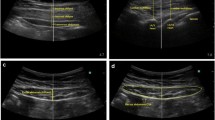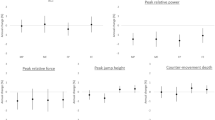Abstract
To evaluate whether regularly performed rowing exercise affects the trunk muscles size and function, and to examine the effect of rowing exercise on thigh muscle size and function in elderly rowers, we compared the cross-sectional area (CSA) and strength of these muscles in elderly male rowers and in age-matched untrained men. Participants were 16 elderly rowing-trained men (ROW age, 67.8 ± 2.3 years) and 18 elderly untrained men (CON 66.2 ± 3.0 years). CSA was measured by MRI in the trunk and thigh muscles. Isometric trunk flexion force and leg extension power were measured. ROW had a 20% larger total trunk muscle CSA than CON (P < 0.01); rectus abdominis was 27% larger, psoas major 64% larger, and erector spinae 14% larger in ROW than in CON (P < 0.05–0.001). Isometric trunk flexion force was related to the CSA of the rectus abdominis (r = 0.777, P < 0.001) and psoas major (r = 0.694, P < 0.001), and was 42% larger in ROW than in CON (P < 0.001). However, force adjusted for the CSA of the muscles did not differ significantly between CON and ROW. In ROW, the CSA was 13% larger in the total thigh muscles (P < 0.01), and leg extension power was 43% higher than in CON (P < 0.001). These results suggest that rowing exercise is a favorable training modality for the trunk muscles, especially psoas major and that it improves thigh muscle size and function in elderly men.


Similar content being viewed by others
References
American College of Sports Medicine Position Stand (1998) The recommended quantity and quality of exercise for developing and maintaining cardiorespiratory and muscular fitness, and flexibility in healthy adults. Med Sci Sports Exerc 30:975–991
Bogduk N, Pearcy MJ, Hadfield G (1992) Anatomy and biomechanics of psoas major. Clin Biomech (Bristol, Avon) 7:109–119
Grabiner MD, Donovan S, Bareither ML, Marone JR, Hamstra-Wright K, Gatts S, Troy KL (2008) Trunk kinematics and fall risk of older adults: translating biomechanical results to the clinic. J Electromyogr Kinesiol 18:197–204
Hosea TM, Boland AL, Simon S, McCarthy K, Kennedy T (1987) Myoelectric and kinematic analysis of the lumbar spine while rowing. Am J Sports Med 115:625
Hughes MA, Myers BS, Schenkman ML (1996) The role of strength in rising from a chair in the functionally impaired elderly. J Biomech 29:1509–1513
Ishida Y, Kanehisa H, Carroll JF, Pollock ML, Graves JE, Ganzarella L (1997) Distribution of subcutaneous fat and muscle thicknesses in young and middle-aged women. Am J Hum Biol 9:247–255
Kanehisa H, Miyatani M, Azuma K, Kuno S, Fukunaga T (2004) Influences of age and sex on abdominal muscle and subcutaneous fat thickness. Eur J Appl Physiol 91:534–537
Kawakami Y, Hirano Y, Miyashita M, Fukunaga T (1993) Effect of leg extension training on concentric and eccentric strength of quadriceps femoris muscles. Scand J Med Sci Sports 3:22–27
Kim JD, Kuno S, Soma R, Masuda K, Adachi K, Nishijima T, Ishizu M, Okada M (2000) Relationship between reduction of hip joint and thigh muscle and walking ability in elderly people (in Japanese). Jpn J Phys Fitness Sports Med 49:589–596
Kim S, Ohshima T, Baba S, Yasuda T, Adachi K, Katsuta S, Okada M, Kuno SY (2001) Effect of long-term exercise on walking ability in elderly people (in Japanese). Jpn J Phys Fitness Sports Med 50:149–157
Krebs DE, Wong D, Jevsevar D, Riley PO, Hodge WA (1992) Trunk kinematics during locomotor activities. Phys Ther 72:505–514
Kuno SY (2000) The relationships between cross-sectional area of psoas major muscle and the ability of running and walking (in Japanese). J Soc Biomech 24:148–152
Lamoureux EL, Sparrow WA, Murphy A, Newton RU (2001) Differences in the neuromuscular capacity and lean muscle tissue in old and older community-dwelling adults. J Gerontol A Biol Sci Med Sci 56A:M381–M385
Larsson L, Grimby G, Karlsson J (1979) Muscle strength and speed of movement in relation to age and muscle morphology. J Appl Physiol 46:451–456
Lexell J, Taylor CC, Sjöström M (1988) What is the cause of the ageing atrophy? Total number, size and proportion of different fiber types studied in whole vastus lateralis muscle from 15- to 83-year-old men. J Neurol Sci 84:275–294
Mannion AF (1999) Fibre type characteristics and function of the human paraspinal muscles: normal values and changes in association with low-back pain. J Electromyogr Kinesiol 9:363–377
Marzani B, Felzani G, Bellomo RG, Vecchiet J, Marzatico F (2005) Human muscle aging: ROS-mediated alterations in rectus abdominis and vastus lateralis muscles. Exp Gerontol 40:959–965
Masuda K, Kim J, Kinugasa R, Tanabe K, Kuno SY (2002) Determinants for stair climbing by elderly from muscle morphology. Percept Mot Skills 94:814–816
Miyatani M, Kanehisa H, Azuma K, Kuno SY, Fukunaga T (2003) Site-related differences in muscle loss with aging, “a cross-sectional survey on the muscle thickness in Japanese men aged 20 to 79 years”. Int J Sport Health Sci 1:34–40
Nelson ME, Rejeski WJ, Blair SN, Duncan PW, Judge JO, King AC, Macera CA, Castaneda-Sceppa C (2007) Physical activity and public health in older adults: recommendation from the American College of Sports Medicine and the American Heart Association. Med Sci Sports Exerc 39:1435–1445
Parkin S, Nowicky AV, Rutherford OM, McGregor AH (2001) Do oarsmen have asymmetries in the strength of their back and leg muscles? J Sports Sci 19:521–526
Penning L (2000) Psoas muscle and lumbar spine stability: a concept uniting existing controversies. Critical review and hypothesis. Eur Spine J 9:577–585
Rodriguez RJ, Rogriguez RP, Cook SD, Sandborn PM (1990) Electromyographic analysis of rowing stroke biomechanics. J Sports Med Phys Fitness 30:103–108
Rubenstein LZ, Josephson KR, Trueblood PR, Loy S, Harker JO, Pietruszka FM, Robbins AS (2000) Effects of a group exercise program on strength, mobility, and falls among fall-prone elderly men. J Gerontol A Biol Sci Med Sci 55A:M317–M321
Sanada K, Miyachi M, Tabata I, Suzuki K, Yamamoto K, Kawano H, Usui C, Higuchi M (2009) Differences in body composition and risk of lifestyle-related diseases between young and older male rowers and sedentary controls. J Sports Sci 27:1027–1034
Secher NH (1983) The physiology of rowing. J Sports Sci 1:23–53
Tachibana K, Yashiro K, Miyazaki J, Ikegami Y, Higuchi M (2007) Muscle cross-sectional areas and performance power of limbs and trunk in the rowing motion. Sports Biomech 6:44–58
Takahashi K, Takahashi HE, Nakadaira H, Yamamoto M (2006) Different changes of quantity due to aging in the psoas major and quadriceps femoris muscles in women. J Musculoskelet Neuronal Interact 6:201–205
Tomonaga M (1977) Histochemical and ultrastructural changes in senile human skeletal muscle. J Am Geriatr Soc 25:125–131
Yoshiga CC, Higuchi M, Oka J (2002a) Serum lipoprotein cholesterols in older oarsmen. Eur J Appl Physiol 87:228–232
Yoshiga CC, Yashiro K, Higuchi M, Oka J (2002b) Rowing prevents muscle wasting in older men. Eur J Appl Physiol 88:1–4
Acknowledgments
The authors express their appreciation to the subjects for their cooperation in this study. This work was supported by a Grant-in-Aid for Scientific Research 20192289 (to M. Higuchi) from the Japan Society for the Promotion of Science; a Research Grant for Health Sciences Research Grants from the Ministry of Health, and Labour and Welfare; and Medical Health Care Research Grants from the Consolidated Research Institute for Advanced Science and Medical Care at Waseda University. This experiment was partly supported by the Grant-in-Aid for the Global COE “Sport Science for the Promotion of Active Life” from the Ministry of Education, Culture, Sports, Science and Technology (MEXT) of Japan.
Author information
Authors and Affiliations
Corresponding author
Additional information
Communicated by Håkan Westerblad.
Rights and permissions
About this article
Cite this article
Asaka, M., Usui, C., Ohta, M. et al. Elderly oarsmen have larger trunk and thigh muscles and greater strength than age-matched untrained men. Eur J Appl Physiol 108, 1239–1245 (2010). https://doi.org/10.1007/s00421-009-1337-6
Accepted:
Published:
Issue Date:
DOI: https://doi.org/10.1007/s00421-009-1337-6




